At Zapier, we believe automation isn’t the opposite of creativity—it’s a way to scale it. When our Brand Studio team applied automation and AI to its own process, we found new space for experimentation, emotion, and storytelling.
ZapConnect is Zapier’s flagship user conference, a celebration of our customers and the incredible things they build. The event helps people apply AI and automation through real use cases, live sessions, and genuine connections. Every year, it brings together over 10,000 attendees from around the world.
And every year, our small Brand Studio team faces the same challenge: how do you get tens of thousands people excited about yet another online event? Why spend hours in front of a screen when ChatGPT can answer almost anything in seconds?
To stand out, an online event has to be more than just content; it has to feel like an experience. Something deep, immersive, and worth remembering. This idea sounds simple, but it’s not easy to do.
That’s where automation came in: not as a shortcut, but as a creative leverage. We used automation to make time for creative storytelling, and AI to reach for unreasonable depth of visual design.
Table of contents:
Developing a creative theme
“AI skilled workers are the new professionals”
“How to adapt to an evolving workforce in the age of AI”
“Companies had fun playing with AI. Now they have to show the returns.”
Every day, headlines like these induce FOMO: move faster, catch up, don’t fall behind. The constant noise around AI creates pressure from all sides. For many, it feels less like opportunity and more like being lost in the dark. Everyone knows they need to start using AI, but few know where to actually begin.
A strong creative theme taps into something relatable. We wanted to turn that FOMO around AI into innocent excitement again. We wanted to remove pressure and bring back the spark of curiosity. If AI makes people feel lost, then what they need most is a guide.
We wanted ZapConnect to do just that: to take the pressure off, to be that guide. To make automation and AI feel approachable and practical. Where attendees could see real use cases, learn from real people, and leave with ideas they could put into action right away.
Light the way became the perfect metaphor for guiding that transformation as a symbol of clarity, discovery, and confidence.
We were tasked with creating a theme that communicated Zapier as the starting point for learning and discovery with AI. The light the way theme and supporting motion graphics and visuals illustrated this journey both literally and metaphorically.
Ashley Hadeed, Senior Design Producer
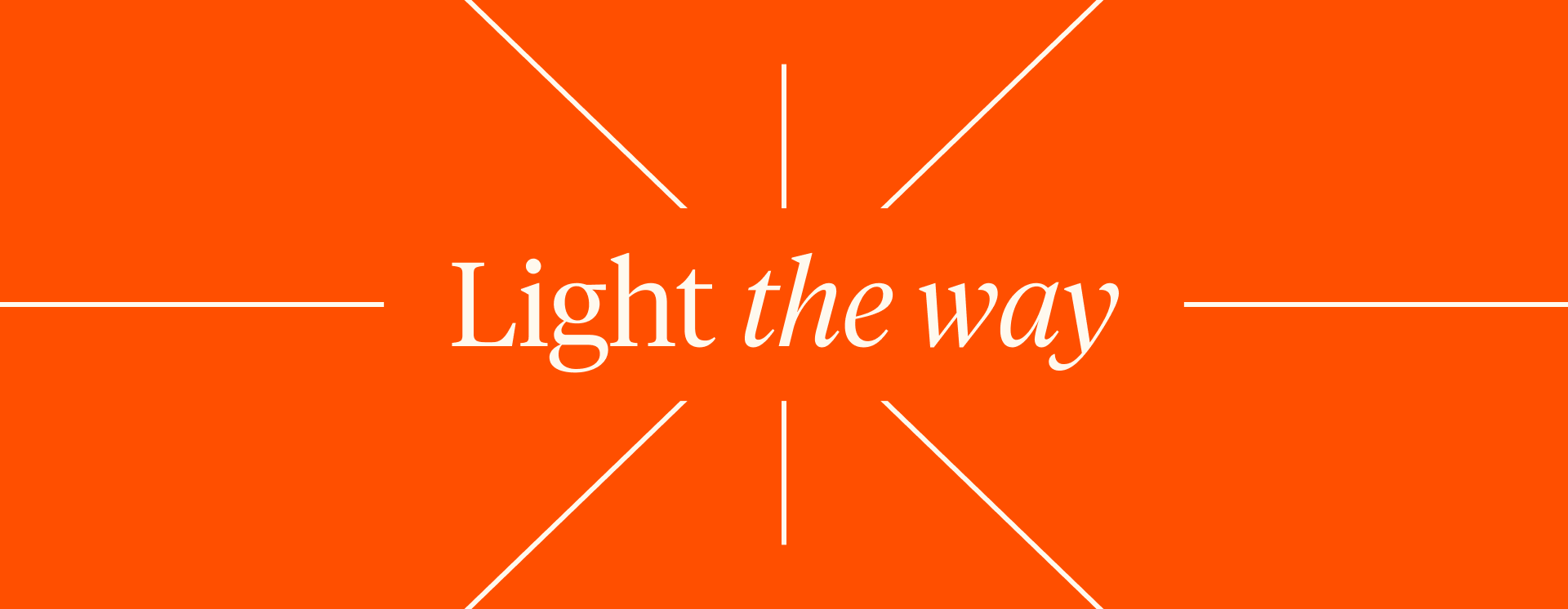
Finding a visual language
Once we defined light as our creative theme, the next step was to give it a form. We had to translate something so abstract into a visual experience people could actually feel.
We knew we’d build within Zapier’s refreshed brand system: the orange core, platform-inspired shapes, and design primitives that make it unmistakably Zapier. But we also wanted to stretch those boundaries to make our online event feel cinematic and alive, while still grounded in our brand language.
To fully live through our theme, we decided to bring AI into the process itself. We wanted to treat it as a chance to create something we couldn’t have created before. Something that’s exciting and fun both for attendees and for us as creators. We wanted to lead by example for creatives still figuring out how to deploy AI meaningfully.
The explorations led us into a creative territory we called The Illuminated Journey. Inspired by films and video games, it told a story where our attendee was a hero. They’re moving through darkness into light. From shadowed caverns of uncertainty, through misty meadows of exploration, and finally into glowing hills of clarity.
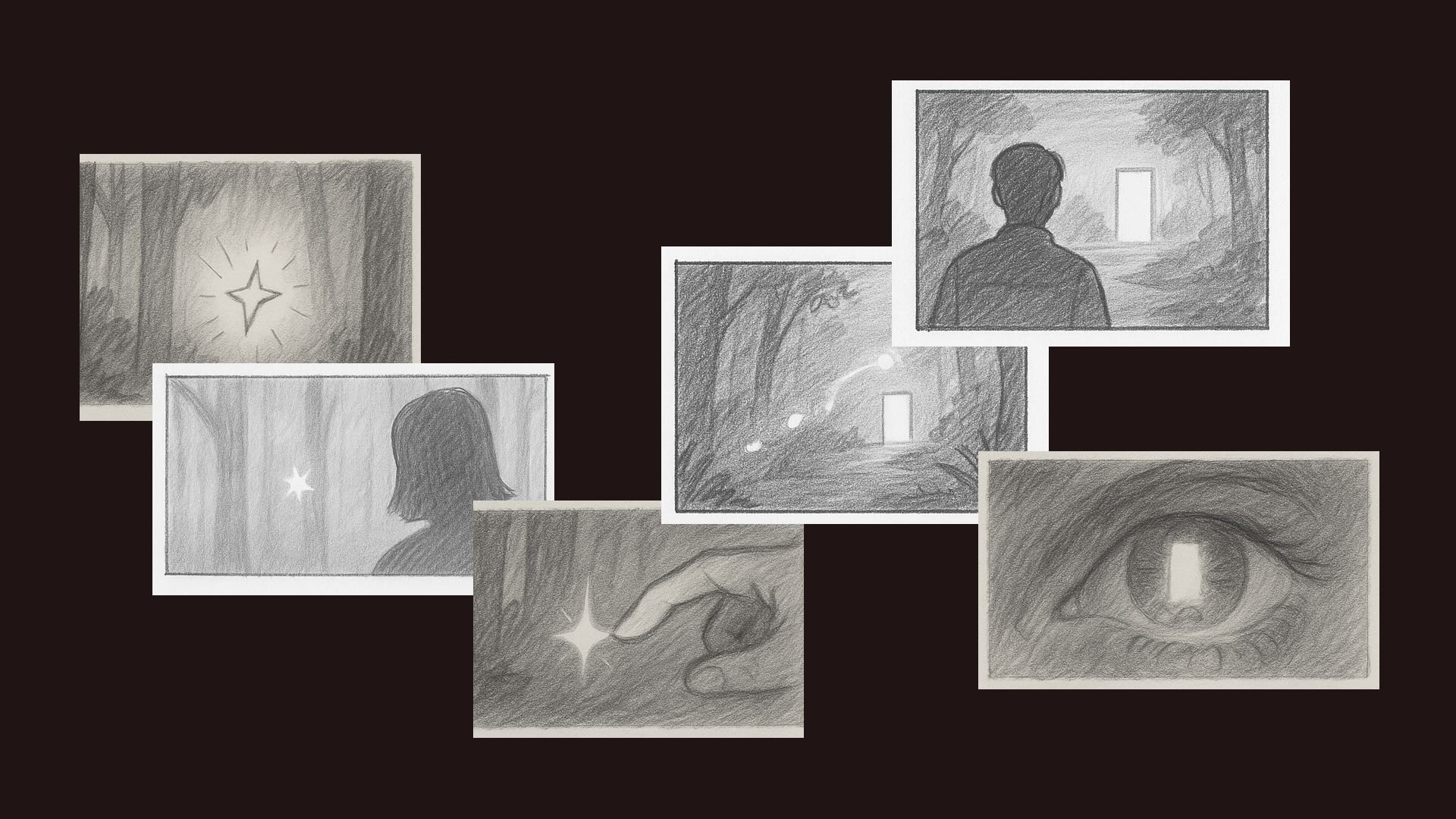
We defined an entire visual system around that journey: cinematic imagery, luminous line beams, motion, sound, and messaging guidelines. Every piece worked together to create a cohesive identity. One that felt flexible, immersive, and scalable across every touchpoint: website, emails, banners, keynote stages, session titles, and recordings.
Scaling imagery with AI
We decided to build the project around imagery, the kind that feels like it’s been lifted straight from a film. Our goal was to create stills with cinematic depth and cinemagraphs with subtle, intriguing motion. But we knew that if the quality fell short, the result could quickly veer into the uncanny or cliché.
Normally, a project like this would call for a studio like Pixar. But we were just a team of four, so we challenged ourselves to see how far AI could take us.
Tools like Midjourney, OpenAI, and Veo offer incredible creative potential. Yet we also understood their limits. AI isn’t easy to control, and strong prompting alone isn’t enough. It takes vision, iteration, and someone willing to dedicate real time and care to shaping the outcome.
At the time, few brands were using AI to create something truly meaningful, and we understood why. It’s powerful but unpredictable, which made it even more exciting for us. We wanted to lead by example and prove that, with the right direction, AI could scale creativity rather than replace it.
To bring that vision to life, we invited AI artist Gizem Akdağ to join our small in-house creative team. With clear direction and a human in the loop, Gizem helped us tap into the full potential of AI-integrated imagery. Together, we developed a cohesive visual series of 14 living images, each supported by motion and sound, that became the core of ZapConnect’s 2025 identity and the visual embodiment of The Illuminated Journey.
Each imagery piece captured a stage of moving from dark to light: from the illuminated cavern (the spark of possibility), through the enchanted forest (exploration), across the misty meadows (experimentation), and finally into the glowing hills (clarity and mastery). The glowing Zapier platform marked the destination: ZapConnect, where AI becomes clear, actionable, and empowering.
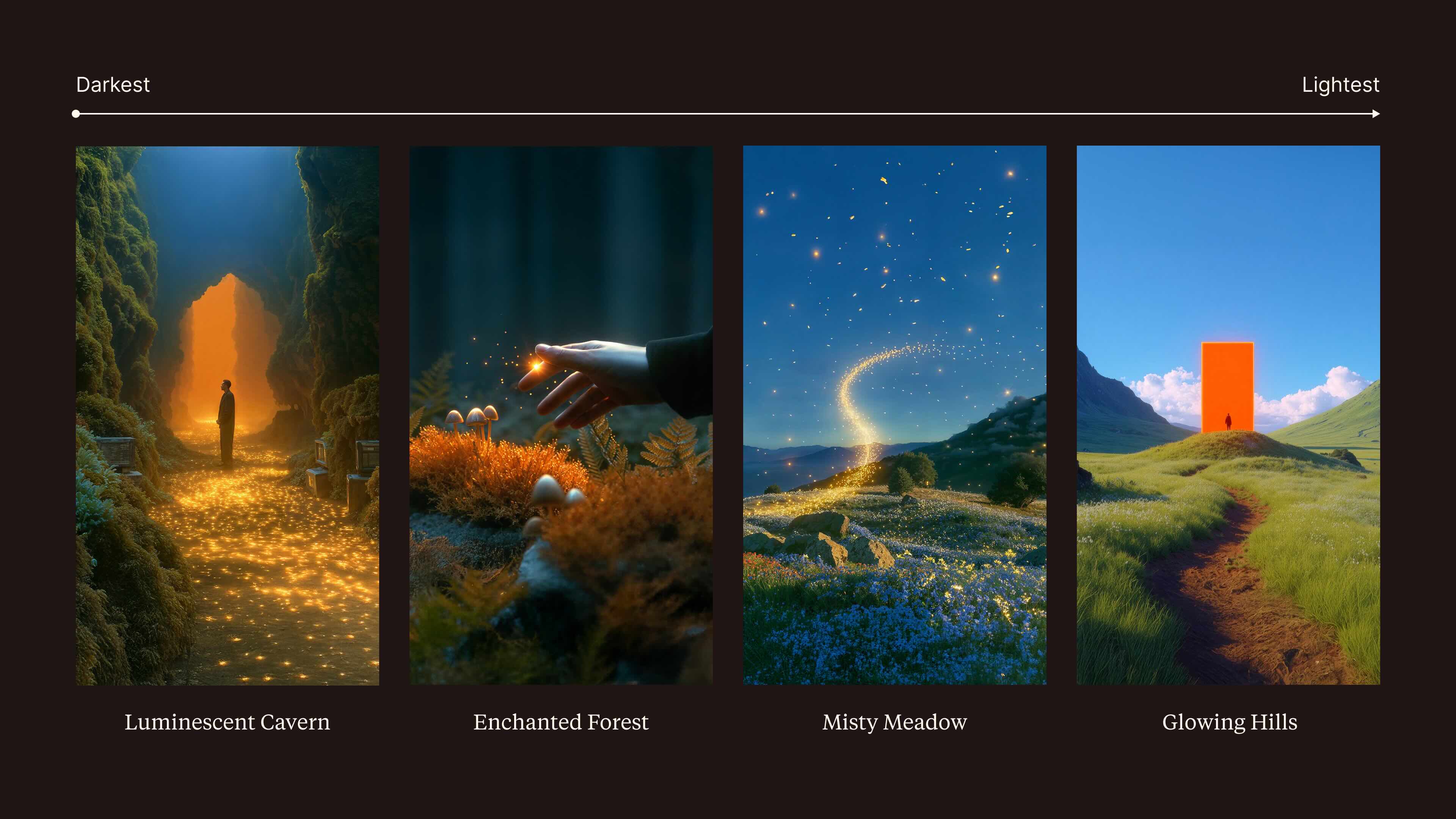
Delivering this successfully became our turning point. The ZapConnect imagery evolved from something decorative into something alive. Every motion loop and image frame carried meaning. It was something we could never have achieved on our timeline or budget without AI.
AI gave us what every creative team dreams of: more time and freedom. We used that extra time to go deeper into craft, to invest in motion, sound, and emotion, to make the experience truly cinematic.
Building event experience with automation
The Illuminated Journey was a foundation for the attendee experience. We mapped our concept of moving from darkness into light across the full attendee path.
From the first click on the registration page to the final moment of the event broadcast, we needed to be intentional about making every interaction feel like a continuation of that journey. It’s one of those things where people won’t notice the separate details, but rather how they come together as an experience.
The website became the first step: light-beam lines guided the eye, creating a sense of forward motion. A “scroll to reveal” effect helped tell the story visually, inviting visitors to dive in and explore.
“We used Framer’s AI Copilot, Workshop, to generate an editable coded component that made the ‘scroll to reveal’ effect easy to maintain,” said Donna Fung, Senior Brand Designer. “Instead of manually updating every word across separate text elements and rebuilding variants each time, we could edit the full paragraph at once. It saved hours of repetitive work and made iteration seamless.”
We applied the same thinking to the event itself, treating the programming as a narrative. Every session was mapped as part of a larger story arc. We wanted ZapConnect to feel like a film you can’t take your eyes off, leaving viewers reflecting once the end credits roll.
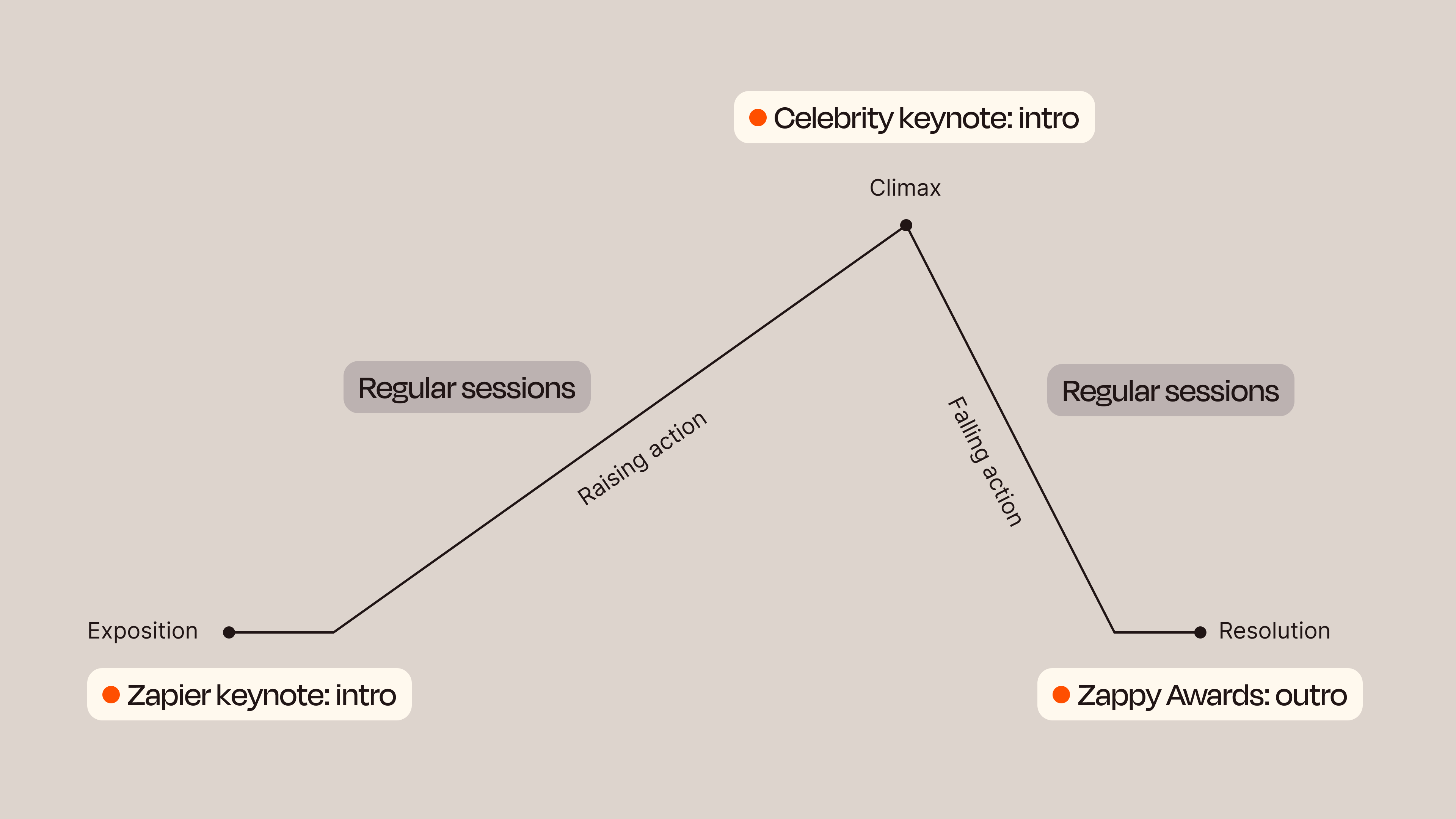
Since our keynote was opening the event, we wanted it to feel as on-brand as possible. So we kicked things off inside Zapier’s signature orange platform, the same one featured on the event cover.
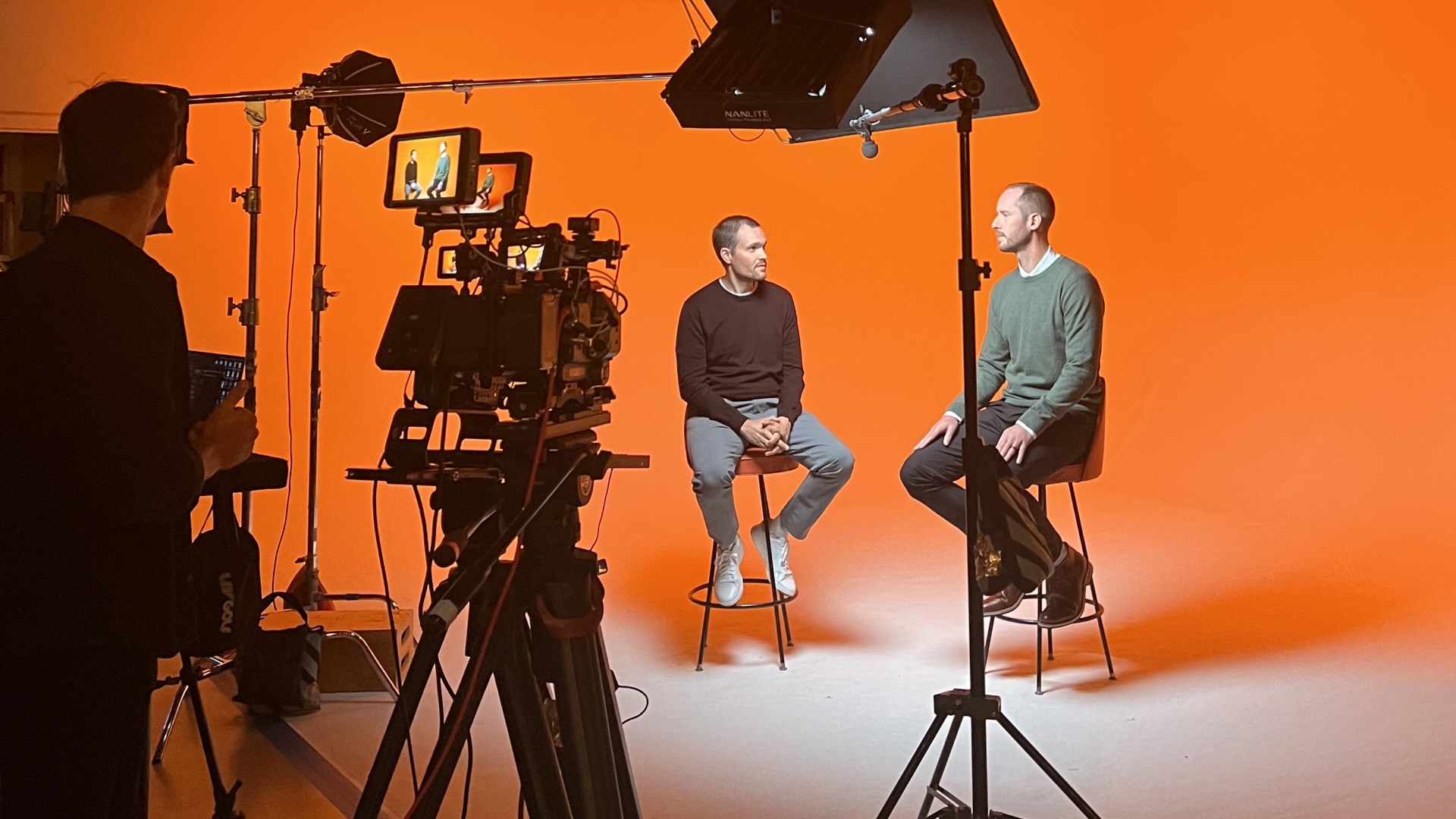
Then, multiple sessions led to the keynote with LeVar Burton. Each one was equipped with intro, outro, and on-brand event assets.
To bring this vision to life across dozens of sessions, we developed an automation that provisioned the assets based on the data pulled from a CSV file.
“I animated five layouts for sessions with one to five speakers and linked every text layer to the CSV. Even music tracks switched automatically depending on the setup,” said Bartłomiej Otłowski, Motion Designer.
This dramatically streamlined production, reduced errors, and saved hours of manual work.
With the time we saved through automation, we could give extra care to the key moments. We created custom intros and outros that became emotional anchors guiding attendees through the story:
-
The Zapier opening keynote – the spark that set the tone
-
Celebrity keynotes with Aaron Levie and LeVar Burton – the story’s peak, full of inspiration
-
The Zappy Awards – the emotional resolution and celebration
-
The event outro – the reflective close, bringing everything full circle
Each asset featured a custom-composed soundtrack by Blake Aaron Henderson, designed to amplify emotion and pace. Every motion loop, transition, and sound motif was tuned to land perfectly with the narrative.
Driving networking with workflows
On-site conferences explode with spontaneous connections. Those moments showing that you’re part of something is what makes an event real. We wanted to bring some of that energy into the digital world.
Since the key token of attending the conference is a badge, we set out to deliver personalized virtual badges. With tens of thousands of participants, automation was the only way. We quickly put together a flow with Zapier and Bannerbear. The system pulled attendees’ details directly from the main registration form, and they could even upload a photo to personalize it further.
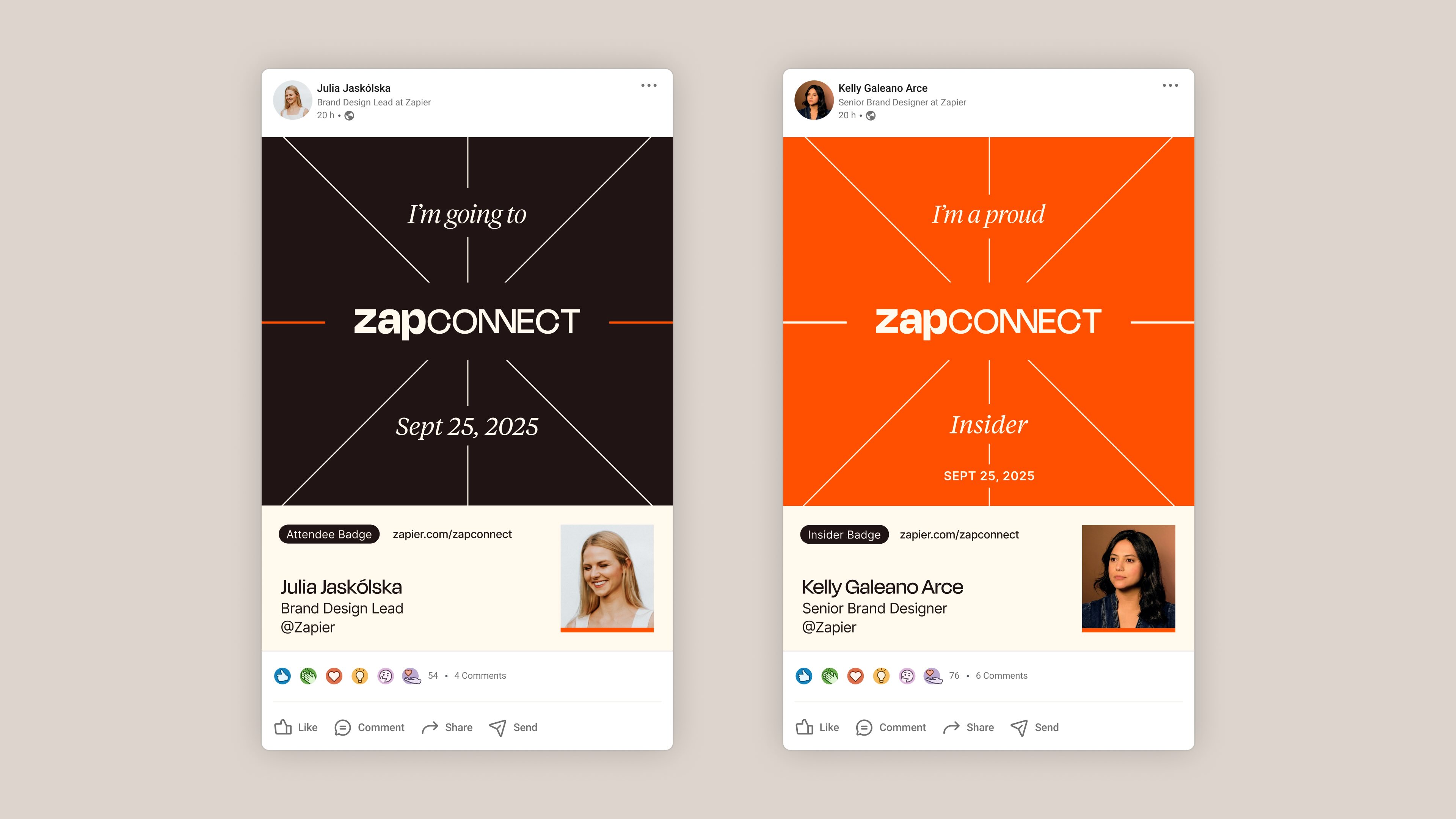
Based on a predesigned template, the automation generated their unique badge image and sent it to them by email, complete with a personalized referral link. Sharing it on LinkedIn or X became an easy, fun way to show up, invite others, and join the larger conversation.
Each share was also tied to our referral program, increasing participants’ chances of winning prizes. What started as a small automation turned into social visibility, word of mouth, and excitement before the event even began.
Enhancing photo assets at scale
In past editions, low-quality or inconsistent headshots slowed production and limited ways of using speaker photos in promotion assets. This year, we wanted our speakers to shine.
We built a human-in-the-loop AI workflow using Zapier. Each speaker uploaded their photo through a Zapier Interface form. From there, the image was analyzed and two versions were generated: an enhanced one and the original. Our team received a Slack notification showing both options and could instantly choose which to keep. Once selected, the Zap automatically removed the background, prepared the image for design, and sent it to a dedicated Google Drive folder for final assets.
All metadata was stored in a Zapier Table, which later became invaluable for production. We could easily export it as a CSV and feed it into Figma Buzz to generate bulk promotional materials in just a few clicks. Fast and reliable, with no room for errors.
These automations made the virtual experience feel more connected and personal. And for us, it meant less repetitive work, fewer bottlenecks, and more time to focus on what we love most: creativity.
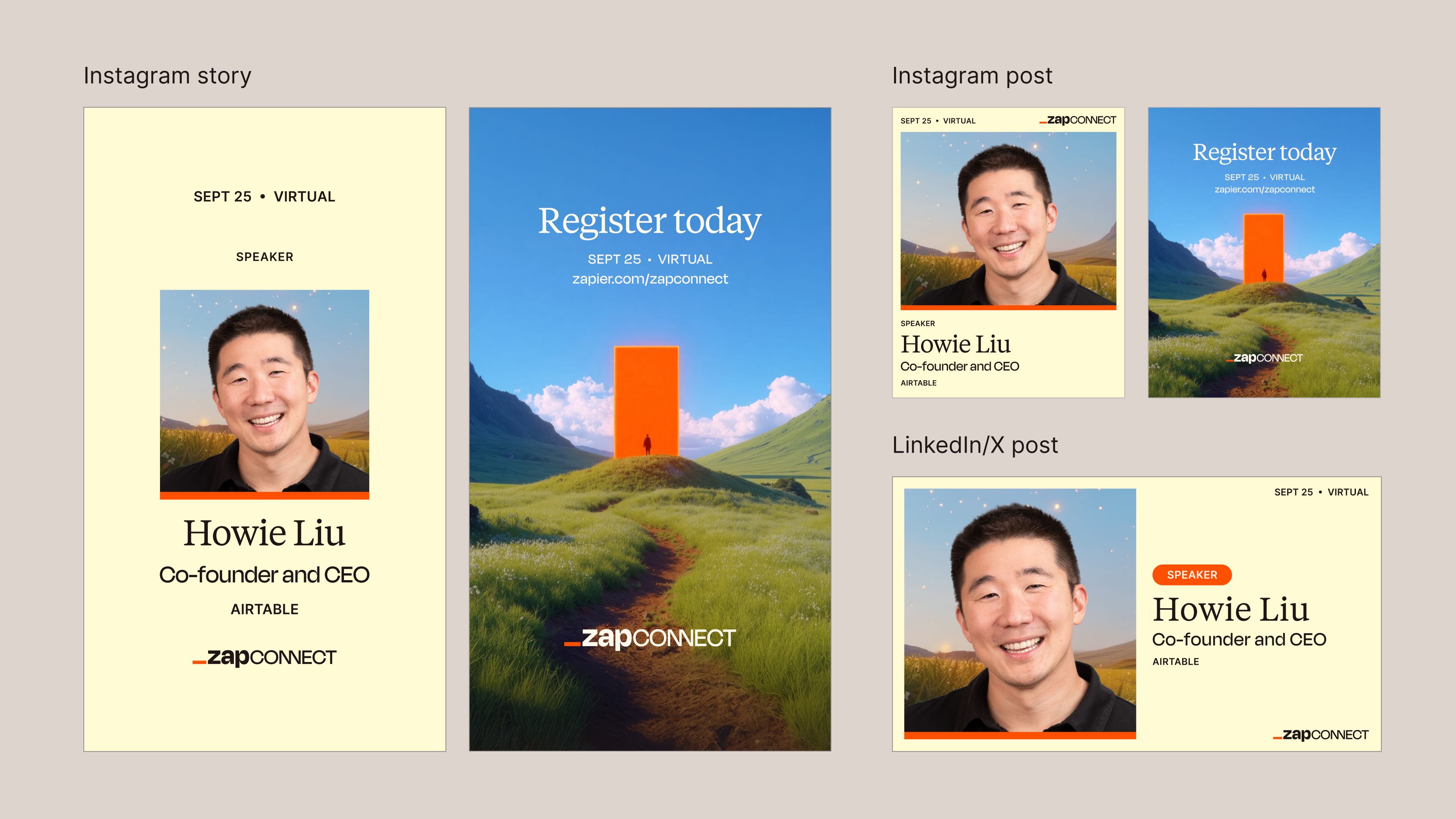
Making a virtual event feel real
Even though ZapConnect takes place entirely online, we wanted it to feel real, something people could see, touch, and interact with. So we created a series of carefully crafted swag packages that extended the experience beyond the screen.
Each package followed the event’s cinematic theme and was filled with thoughtful details that carried meaning. Inside, attendees discovered movie-like posters inspired by our AI-integrated imagery, along with glowing in the dark stickers or caps featuring phrases such as “Follow the spark.” Some even included a Philips Hue orange lamp, a playful nod to automation that quite literally brought our theme of light to life.
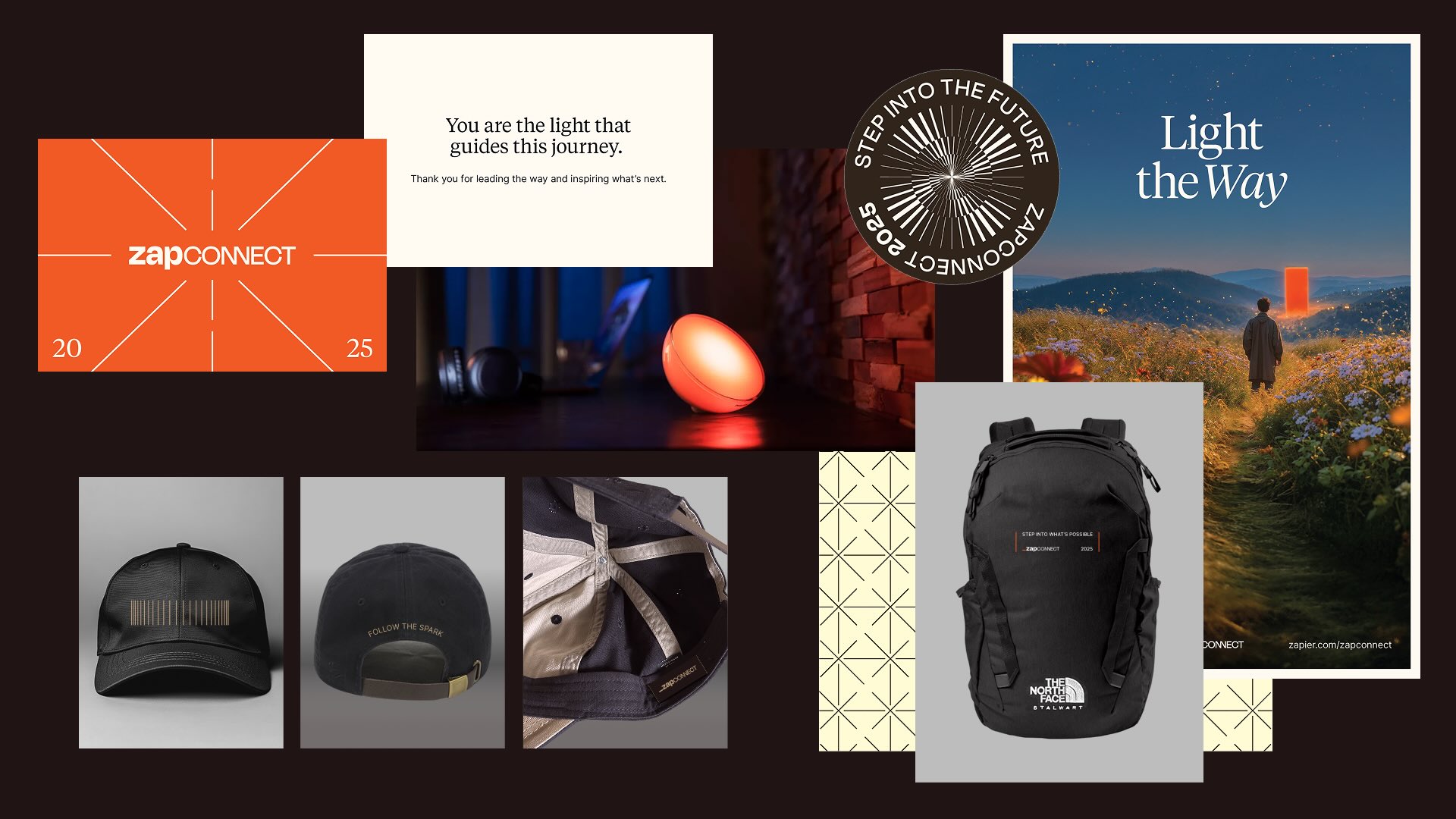
Special swag items were also part of a gamification program designed to encourage participation and keep energy high throughout the event. Showcasing these prizes, like Meta Ray-Bans, transparent speakers, or red light masks, played a big role in building excitement.
The challenge was that the original product photos from different manufacturers all looked inconsistent and off-brand, making it difficult to present them as part of a cohesive experience.
To solve that, we turned to AI tools to reimagine the visuals. Instead of relying on professional photo shoots, we transformed standard product images into cinematic, branded assets that matched the event’s aesthetic in no time.
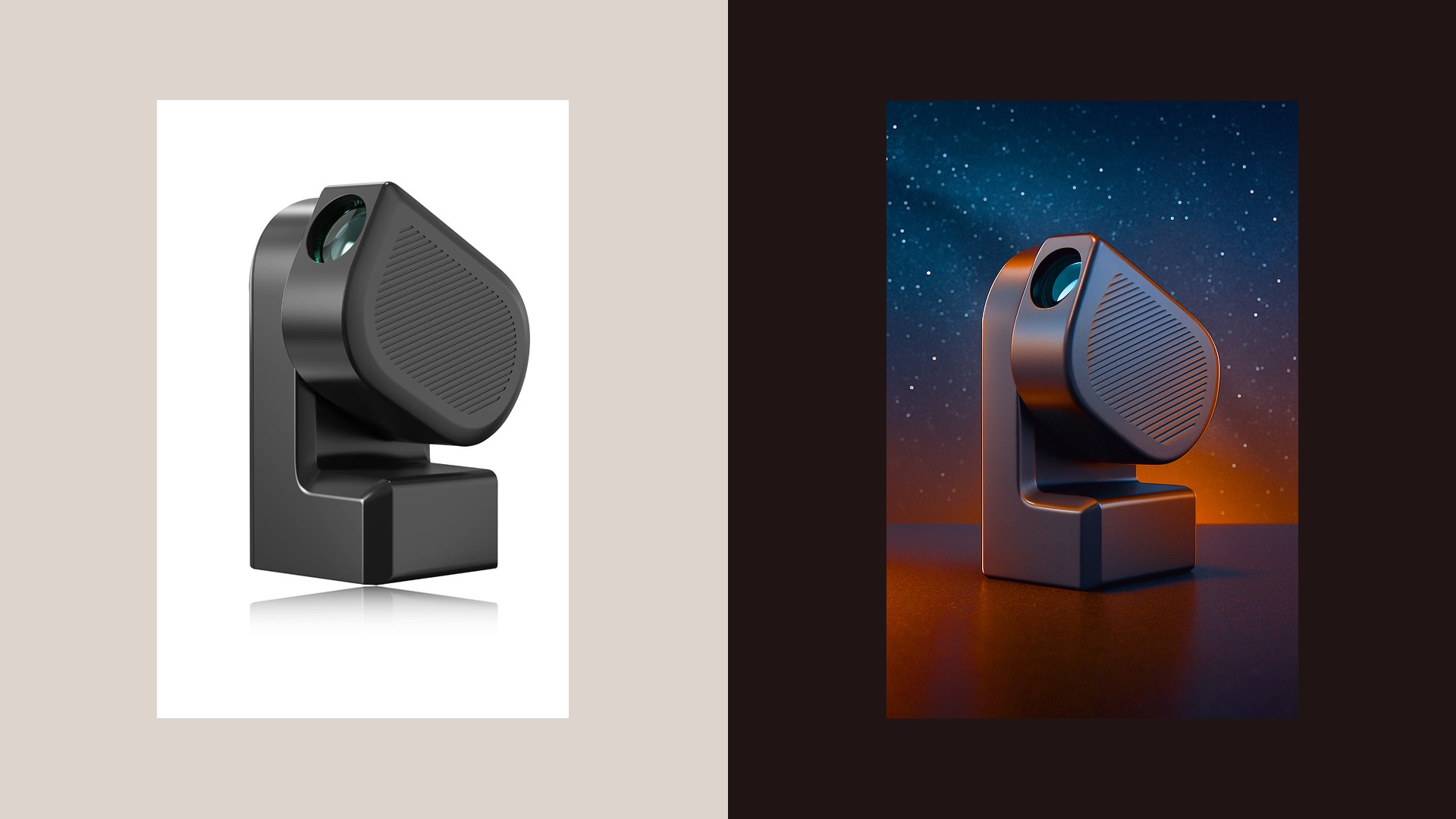
Every package became a small but deliberate act of storytelling—proof that even in a virtual format, design and automation can work together to create something people don’t just attend, but experience.
Can automation scale creativity?
We underestimated just how much AI and automation could scale creativity.
As a small team of four, we took on an ambitious challenge, and we’re incredibly proud of what we achieved. Thanks to AI automation, we reached a level of cinematic quality that few would attempt through traditional means.
AI gave us incredible speed and scale, but it was still the human input that made the work meaningful.
Kelly Galeano Arce, Senior Brand Designer
And it paid off: this year, ZapConnect drove a 25% year-over-year increase in registrations, and up to a 33% lift across visually rich channels. We reached our overall attendee goals, and received multiple positive reactions:
-
“It is one of the most pleasantly accessible and experiential online events that exists.”
-
“The visuals and music were beautiful! Everything felt immersive and elevated. Complete opposite of staring at a screen unengaged.”
-
“This event invitation email has everything: clean layout, perfect mobile optimization, dark mode support, and those signature Zapier white space vibes.”
If a brand is a person, the brand’s conference is their party. It’s a unique opportunity for the brand to dress up some new clothes, get a new shade, a new touch of distinctiveness. This depth is what drives brand loyalty and turns your customers into brand advocates:
For any brand studio out there, or anyone in a creative field, these are extraordinary times. We can reach for unreasonable means of creativity. The possibilities are expanding faster than ever, and the stage for creatives just keeps getting bigger.
“AI gave us incredible speed and scale, but it was still the human input that made the work meaningful,” said Kelly Galeano Arce, Senior Brand Designer. “Gizem went through thousands of iterations to get each image to feel right—to capture emotion, atmosphere, and intent. The same was true for the event’s soundtrack. Someone asked if we used AI to compose it, but the truth is that the quality we achieved came from working with a real artist who could shape feeling, not just sound. That’s where human talent still makes all the difference.”
AI helped us grow ideas and move faster, while human judgment shaped the emotion and timing. Neither could have done it alone, but together, they created something truly immersive. If your team hesitates to dive in, think no more and dive deep.
One final use case for the time we saved was an Easter egg. We managed to sneak it in at the very end of the event: a cinematic credits roll for the team. It completed the circle of our story and reminded us that a strong event identity doesn’t just work outward, but inward too.